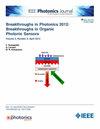A Moderate Confinement O-, S-, C-, and L-Band Silicon Nitride Platform Enabled by a Rapid Prototyping Integrated Photonics Foundry Process
IF 2.1
4区 工程技术
Q3 ENGINEERING, ELECTRICAL & ELECTRONIC
引用次数: 0
Abstract
We describe a rapid prototyping process for silicon nitride photonic integrated circuits operating at wavelengths around 1.3 and 1.5 μm. Moderate confinement silicon nitride waveguides and other essential integrated photonic components, such as fiber-chip couplers, microring resonators, multimode interference-based 3-dB power splitters, and subwavelength grating metamaterial waveguides, were fabricated and characterized and are reported. The prototyping platform features a 400-nm-thick layer of silicon nitride grown via low-pressure chemical vapour deposition onto 4” silicon thermal oxide wafers and uses direct-write electron beam lithography to define single mode waveguide structures that exhibit losses of <1.3 dB/cm across the O-band (1260–1360 nm), <1.8 dB/cm across the S-band (1460–1530 nm), <1.6 dB/cm across the C-band (1530–1565 nm), and <0.7 dB/cm across the L-band (1565–1625 nm) for both transverse electric (TE) and transverse magnetic (TM) polarizations. The reported components were compiled into a process design kit to accompany the platform, which is commercially available through the NanoSOI Design Center operated by Applied Nanotools Inc. with five multi-project wafer runs per year that have fast turnaround times on the scale of weeks rather than months. This provides a route toward the rapid fabrication of silicon nitride chip-based passive and thermo-optic active photonic devices with critical resolution down to 120 nm, making it an attractive solution for entry-level designers, device innovators, and small companies looking to incorporate integrated silicon nitride circuits into early-stage applications of silicon photonics.快速成型集成光子铸造工艺实现的中等约束O, S, C和l波段氮化硅平台
我们描述了一种工作波长在1.3和1.5 μm左右的氮化硅光子集成电路的快速成型工艺。本文制备了中等约束氮化硅波导和其他重要的集成光子元件,如光纤芯片耦合器、微环谐振器、基于多模干涉的3db功率分配器和亚波长光栅超材料波导,并对其进行了表征。原型平台的特点是通过低压化学气相沉积在4英寸硅热氧化物晶圆上生长400纳米厚的氮化硅层,并使用直写电子束光刻来定义单模波导结构,其在o波段(1260-1360 nm)的损耗<1.3 dB/cm,在s波段(1460-1530 nm)的损耗<1.8 dB/cm,在c波段(1530-1565 nm)的损耗<1.6 dB/cm。横向电极化(TE)和横向磁极化(TM)在l波段(1565-1625 nm) <0.7 dB/cm。该平台通过应用纳米工具公司(Applied Nanotools Inc.)运营的NanoSOI设计中心(NanoSOI design Center)进行商业化,每年可运行5个多项目晶圆,周转时间缩短至数周,而不是数月。这为快速制造基于氮化硅芯片的无源和热光有源光子器件提供了一条途径,其临界分辨率低至120纳米,使其成为入门级设计师,设备创新者和希望将集成氮化硅电路集成到硅光子学早期应用中的小公司的有吸引力的解决方案。
本文章由计算机程序翻译,如有差异,请以英文原文为准。
求助全文
约1分钟内获得全文
求助全文
来源期刊

IEEE Photonics Journal
ENGINEERING, ELECTRICAL & ELECTRONIC-OPTICS
CiteScore
4.50
自引率
8.30%
发文量
489
审稿时长
1.4 months
期刊介绍:
Breakthroughs in the generation of light and in its control and utilization have given rise to the field of Photonics, a rapidly expanding area of science and technology with major technological and economic impact. Photonics integrates quantum electronics and optics to accelerate progress in the generation of novel photon sources and in their utilization in emerging applications at the micro and nano scales spanning from the far-infrared/THz to the x-ray region of the electromagnetic spectrum. IEEE Photonics Journal is an online-only journal dedicated to the rapid disclosure of top-quality peer-reviewed research at the forefront of all areas of photonics. Contributions addressing issues ranging from fundamental understanding to emerging technologies and applications are within the scope of the Journal. The Journal includes topics in: Photon sources from far infrared to X-rays, Photonics materials and engineered photonic structures, Integrated optics and optoelectronic, Ultrafast, attosecond, high field and short wavelength photonics, Biophotonics, including DNA photonics, Nanophotonics, Magnetophotonics, Fundamentals of light propagation and interaction; nonlinear effects, Optical data storage, Fiber optics and optical communications devices, systems, and technologies, Micro Opto Electro Mechanical Systems (MOEMS), Microwave photonics, Optical Sensors.
 求助内容:
求助内容: 应助结果提醒方式:
应助结果提醒方式:


